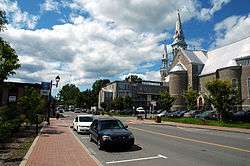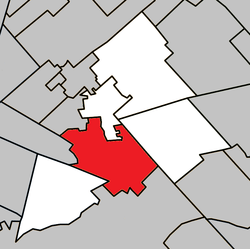Saint-Jérôme, Quebec
| Saint-Jérôme | ||
|---|---|---|
| City | ||
 | ||
| ||
 Location within La Rivière-du-Nord RCM. | ||
 Saint-Jérôme Location in central Quebec. | ||
| Coordinates: 45°47′N 74°00′W / 45.783°N 74.000°WCoordinates: 45°47′N 74°00′W / 45.783°N 74.000°W[1] | ||
| Country |
| |
| Province |
| |
| Region | Laurentides | |
| RCM | La Rivière-du-Nord | |
| Settled | 1834[2] | |
| Constituted | January 1, 2002 | |
| Government[3] | ||
| • Mayor | Marc Gascon | |
| • Mayor-elect | Stéphane Maher | |
| • Federal riding | Rivière-du-Nord | |
| • Prov. riding | Saint-Jérôme | |
| Area[3][4] | ||
| • Total | 92.90 km2 (35.87 sq mi) | |
| • Land | 90.52 km2 (34.95 sq mi) | |
| Population (2011)[4] | ||
| • Total | 68,456 | |
| • Density | 756.3/km2 (1,959/sq mi) | |
| • Pop 2006-2011 |
| |
| Time zone | EST (UTC−5) | |
| • Summer (DST) | EDT (UTC−4) | |
| Postal code(s) | J5L, J7Y, J7Z | |
| Area code(s) | 450 and 579 | |
| Highways |
| |
| Website |
www | |
Saint-Jérôme (French pronunciation: [sɛ̃ ʒeʁom])(2011 Population 68,456) is an off-island suburb of Montreal, located about 60 kilometres (37 mi) northwest of Montreal along Autoroute des Laurentides. The town is a gateway to the Laurentian Mountains and its resorts.
The town is named after Saint Jerome (ca. 347 – September 30, 420), a church father best known as the translator of the Bible from Greek and Hebrew into Latin. His translation is known as the Vulgate.
History
.jpg)
The territory where the present city of Saint-Jérôme now stands was granted in 1752 by the marquis de la Jonquière, governor of New France, as the seignory of Augmentation des Mille-Iles (literally "enlargement" of the seignory of Mille-Iles). From the 1760s to the 1840s, the seignory was owned by the Dumont and Lefebvre de Bellefeuille families, living in the town of Saint-Eustache, 25 kilometers (16 mi) to the south. The Dumont and the Lefebvre conceded the farmland to colonists coming mostly from the region lying north of Montreal. The emerging town was then known under the name of Dumontville. The Catholic parish of Saint-Jérôme was constituted on November 15, 1834 and the village itself was constituted on July 1, 1845 by governor Metcalfe.[5]
François-Xavier-Antoine Labelle, a Roman Catholic priest who was the great "colonizer" (promoter of settlement) of the North of Montreal, was in charge of the pastoral administration of Saint-Jérôme of 1868 until his death, in 1891. Eight years after his arrival, he had a railroad built linking Saint-Jérôme and Montreal.
Antoine Labelle was the parish priest of Saint-Jérôme for 22 years, from 1868 until his death, at 57 years of age, on January 4, 1891. He was called "the king of North, the apostle of colonization".
The opening of roads and the arrival of a railroad became essential with the development of the small communities in the Laurentians. These transportation routes for the movement of goods and people would ensure the establishment of trade and industry.
Labelle promoted the idea of a railroad towards the North beginning in 1869. The railway reached Saint-Jérôme in 1876, partly because a railway was seen as a way to meet the needs for firewood and construction materials for urban centres like Montreal and Quebec.
In 2002 Saint-Jérôme amalgamated with the municipalities of Bellefeuille (2001 census population 14,066), Saint-Antoine (2001 population 11,488) and Lafontaine (2001 population 9,477).
Saint-Jérôme is the seat of the judicial district of Terrebonne.[6]
Transportation
Road
Saint-Jérôme is served by Québec Autoroute 15, and Québec Route 117, which is part of the Trans-Canada Highway. In addition, Québec Routes 158 and 333 pass through the city.
Public Transportation
Train
Saint-Jérôme is served by the Saint-Jérôme intermodal commuter rail station on the Agence métropolitaine de transport's Saint-Jérôme Line. Commuter trains to Montreal began to serve the station in January 2007, with four trains in each direction each business day.[7]
Since upgrades to the line were made in 2013, which included work to double the track between Sainte-Rose station and Saint-Martin Junction and install Automatic Train Control (ATC) between Parc station and the end of the line in Saint-Jérôme, all trains now serve the station. There are currently 13 departures towards Montreal during the week, and six departures on the weekends and holidays.[8]
Bus
The station is also served by bus routes operated by local transit agency, CIT Laurentides, and the neighbouring transit agency CRT Lanaudière as well as three private intercity bus companies.
Trails
Saint-Jérôme is an important stop on the north-south trunk of the "route verte" cycling path which makes it possible for nature lovers who are also pedaling enthusiasts to make short trips or excursions lasting several days from as far south as Blainville, Quebec on the outskirts of Montreal and as far north as Mont-Tremblant, Quebec without ever sharing the road with a motorized vehicle. North of Saint-Jérôme, the trail is known as the "P'tit Train du Nord" linear park (rail trail)[9] and is also used as a cross-country ski trail in winter.
Industry
.jpg)
Uniroyal, Dominion Rubber
- In 1911, first rubber industry in St-Jerome, shoes production
- In 1926, the industry is renamed Dominion Rubber.
- In the 1950s, 37,000 shoes where produced for all over the world.
- In 1966, the company is renamed UNIROYAL LTD.
- In 1968, the company changed its production for automobile parts, crashpad.
- In 1981, the company was sold to many cities like Woodbridge and Waterville.
- In 1994 the building was demolished.
Health
Institutional health care
The Centre de santé et de services sociaux de Saint-Jérôme (Health and Social Services Centre of Saint-Jérôme or CSSS) is the non-profit body that operates three different types of health care institution in the city: an acute-care hospital (the Hôpital régional de Saint-Jérôme), the CLSC and long-term care facilities. By its regional vocation, it serves the entire Laurentides region. The history of the CSSS of Saint-Jerome begins with the construction of the hospital in 1949 and its opening the following year.
The main purpose of the establishment is to offer care and high quality services to the population. In April 2007, the CSSS obtained accreditation from Accreditation Canada. This distinction confirms adequate standards of care and patient safety.
Education
Saint-Jérôme is home to the Cégep de Saint-Jérôme, one of the Colleges of General and Vocational Education located in the province. It is also home to a new Saint-Jérôme branch campus of the Université du Québec en Outaouais.
The Commission scolaire de la Rivière-du-Nord operates French-language public schools.
Attractions

- Roman Catholic cathedral, which includes a small museum
- Vieux-Palais modern art museum and public library
- Musée d'art contemporain des Laurentides
- Statue of Antoine Labelle, known as curé Labelle, who was principally responsible for the settlement of the Laurentians
- Several summer festivals
- Carrefour du Nord, a regional shopping mall
- Melançon Arena, an indoor arena
Demographics
According to the 2011 Canadian Census,[10] the population of Saint-Jérôme is 68,456, a 7.4% increase from 2006. The population density is 756.3 people per square km. The median age is 43.9 years old, a bit older than the national median at 40.6 years old. There are 32,534 private dwellings with an occupancy rate of 95.6%. According to the 2011 National Household Survey, the median value of a dwelling in Saint-Jérôme is $200,049 which is lower than the national average at $280,552. The median household income (after-taxes) in Saint-Jérôme is $40,544, a fair bit lower than the national average at $54,089.
Saint-Jérôme is mostly made up of European descents. The racial make up of Saint-Jérôme is:
- 96.6% White
- 1.0% Aboriginal; 0.5% First Nations, 0.4% Metis
- 0.9% Latin American
- 0.6% Black
- 0.3% South Asian
- 0.2% East Asian; 0.2% Chinese, 0.0% Korean, 0.0% Japanese
- 0.2% Arab
- 0.1% Southeast Asian; 0.0% Filipino
- 0.0% West Asian
- 0.1% Multiracial; 0.5% including Metis
- 0.0% Other
Most of Saint-Jérôme's population is either Christian (88.1%), or affiliates with no religion (11.1%). The remaining 0.8% affiliate with another religion.
Population trend:[11]
- Population in 2011: 68,456 (2006 to 2011 population change: 7.4%)
- Population in 2006: 63,729
- Population in 2001: 59,614
- Saint-Jérôme: 24,583
- Bellefeuille: 14,066
- Saint-Antoine: 11,488
- Lafontaine: 9,477
- Population in 1996:
- Saint-Jérôme: 23,916
- Bellefeuille: 12,803
- Saint-Antoine: 10,806
- Lafontaine: 9,008
- Population in 1991:
- Saint-Jérôme: 23,384
- Bellefeuille: 10,883
- Saint-Antoine: 10,232
- Lafontaine: 7,365
The 2006 census found that 95.6% of residents spoke French as their mother tongue.
The next most common languages were English (1.4%) and Spanish (1.0%).[12]
| Mother Tongue | Population | Percentage |
|---|---|---|
| French | 59,795 | 95.58% |
| English | 855 | 1.37% |
| English and French | 315 | 0.50% |
| French and a non-official language | 45 | 0.07% |
| English and a non-official language | 25 | 0.04% |
| Spanish | 630 | 1.01% |
| Italian | 205 | 0.33% |
| Greek | 135 | 0.22% |
| Chinese | 90 | 0.14% |
| Serbo-Croatian | 65 | 0.10% |
Notable people
- Tod Campeau, Professional hockey player
- Jonathan Huberdeau, Professional hockey player
- Boule Noire, singer
- Marc Nadon, Supreme Court nominee
- Little Beaver, wrestler
Twin towns
- Lisieux, France - since May 2010?
See also
References
- ↑ Reference number 151354 of the Commission de toponymie du Québec (French)
- ↑ Histoire de Saint-Jérôme
- 1 2 Geographic code 75017 in the official Répertoire des municipalités (French)
- 1 2 "(Code 2475017) Census Profile". 2011 census. Statistics Canada. 2012.
- ↑ Auclair, Elie-J., Saint-Jérôme de Terrebonne, Imprimerie J.H.A. Labelle, 1934, pages 13-35.
- ↑ Territorial Division Act. Revised Statutes of Quebec D-11.
- ↑ La Presse, 28 novembre 2006 "Saint-Jérôme aura son train de banlieue" par Jean-Paul Charbonneau
- ↑ AMT Schedules Saint-Jérôme
- ↑ Government of Quebec – Parc Linéaire Le P'tit Train du Nord
- ↑ 2011 NHS/Census Profile of Saint-Jérôme: http://www12.statcan.gc.ca/nhs-enm/2011/dp-pd/prof/details/page.cfm?Lang=E&Geo1=CSD&Code1=2475017&Data=Count&SearchText=Saint-Jerome&SearchType=Begins&SearchPR=01&A1=All&B1=All&Custom=&TABID=1
- ↑ Statistics Canada: 1996, 2001, 2006, 2011 census
- ↑ "Saint-Jérôme, V". Detailed Mother Tongue (103), Knowledge of Official Languages (5), Age Groups (17A) and Sex (3) for the Population of Canada, Provinces, Territories, Census Divisions and Census Subdivisions, 2006 Census - 20% Sample Data. Statistics Canada. 2007-11-20. Retrieved 2008-08-02.
External links
| Wikimedia Commons has media related to Saint-Jérôme. |
- Ville de Saint-Jérôme, in French
- Commission de toponymie du Québec - Saint-Jérôme, in French
- Cégep de Saint-Jérôme, in French
- Best Western St-Jérome
 |
Sainte-Anne-des-Lacs | Prévost |  | |
| Mille-Isles | |
Sainte-Sophie | ||
| ||||
| | ||||
| Saint-Colomban | Mirabel |
.svg.png)
.jpg)